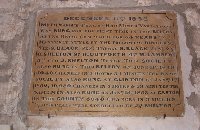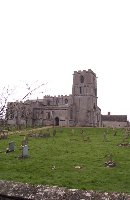
In "Dixon's" Bob Minor, all bells ring plain hunt, except that 2nds is made whenever the treble leads, as in plain bob, and 4ths is made whenever bells two or four lead. The plain course is 64 changes, and standard 14 and 1234 calls are used when the treble is leading to produce an extent.
To recreate the historic performance, a Cambridge University Guild band travelled to Maxey on December 29th 2001 and rang a peal of Dixon's Bob Minor.
Cambridge University Guild
Maxey, Cambridgeshire
Saturday 29 December 2001 in 2h56
5040 Dixon's Bob Minor
Composed by: A E Holroyd 1,3,5,7(Queens'),
P A B Saddleton 2,4,6(Trinity)
1)A J W Tibbetts (C) (St Catharine's)
2)I J Wells (Corpus Christi)
3)J E Galloway (New Hall)
4)S C Farrar (Jesus)
5)P J Earis (Clare)
6)J D Shanklin (Magdalene)
Believed to be the first peal of Dixon's Bob Minor.
100th Peal: 4
The Classification Problem
Dixon's Bob minor is not easy to classify. Unlike all methods, it cannot really be described by a place-notation. In Dixon's, different leads have different numbers of changes, depending on the relative positions of bells two and four: a lead may have between 8 and 16 changes. The Central Council requirements for methods state that a method is defined by the places made between successive rows of its plain course, divisible into equal parts called leads; clearly Dixon's doesn't qualify as a method under the current rules.
 It cannot be considered a plain bob, with bobs made whenever bells two or four lead, as this does not conform to the decisions on calls, since a call "is effected by altering the places made between two consecutive rows, without altering the length of a lead". However, there is a historical precedent breaking this rule: in Clavis Campanalogia (1788), there is a 720 by John Holt with three extra bobs affecting the treble, to give a bobs-only extent.
It cannot be considered a plain bob, with bobs made whenever bells two or four lead, as this does not conform to the decisions on calls, since a call "is effected by altering the places made between two consecutive rows, without altering the length of a lead". However, there is a historical precedent breaking this rule: in Clavis Campanalogia (1788), there is a 720 by John Holt with three extra bobs affecting the treble, to give a bobs-only extent.There are nine possible leads in Dixon's, of which three are symmetrical (and could be regarded as Little Bob, Single Court and Yaxley Alliance), and three asymmetric pairs. Each of these has a five-lead course, and can be considered as a method, except for the pair where two and four are in 26 or 36 at the lead-head. Here, the treble dodges once in the lead, giving a six-lead course and an out of course lead-head. With a 14 lead-head, these each give the same symmetric method with two hunt-bells. The Central Council decision states that, "Compositions in more than one method in which the change of method occurs at the lead-head and/or the half-lead shall be called 'spliced'." Is it permissible to have the lead-head in a different place in different leads of the same method? Or to have two methods with the same place-notation, but starting in a different place in each? Whilst Dixon's may be able to be classified as 'spliced' under the current decisions, it hardly accurately and elegantly represents what was rung.
Under the current decisions, Dixon's could be described as an extent of Original Minor, with three types of calls (12, 14 and 1234), and silent calls being used whenever bells two, four, or the treble (at plain leads) were leading. However, this is not what we rang. Extending this logic, Plain Bob Minor should be considered as Original Minor with silent 12 calls when the treble leads.
What we rang, despite being a true extent, certainly does not fit easily into the current requirements. Unlike nearly everything rung before, it is rule-based rather than method-based. How should Dixon's Bob Minor, and other rule-based constructions be categorised? Furthermore, is the current requirement that a peal should be rung in methods really necessary?
Expansion of the rule-based construction
Dixon's is just one example of what can be defined as a rule-based construction: the feature being that the transition from one row to the next depends upon the particular row, and not simply the number of rows that have been rung. There is not necessarily a dichotomy here: methods with a hunt-bell can be defined by the work done relative to the hunt, and many of the rules by which we learn and ring methods are based on what the treble is doing. Many ringers ring plain bob solely by dodging when the treble leads, for example.
When it comes to composition, the Q-set laws mean that often it is easier to learn a rule for constructing a composition rather than the order of the calls (certainly it helps if the conductor can work out from the current rows or coursing order where in the composition he is). A few examples:
In all of these there is a hunt-bell that repeats its work throughout the composition. The difference with Dixon's is that the work of the treble varies according to the position of the other bells. This is what makes it difficult to reconcile with the current CC decisions.
 There have been attempts to extend the idea, but unless the rules are carefully chosen it can prove difficult to get something to work. Particularly on lower numbers, when an extent is required, it is desirable that the rows either side of a given row are unique: this should allow the extent to be split up into mutually true blocks, and so prevent any falseness problems. Some possibilities are:
There have been attempts to extend the idea, but unless the rules are carefully chosen it can prove difficult to get something to work. Particularly on lower numbers, when an extent is required, it is desirable that the rows either side of a given row are unique: this should allow the extent to be split up into mutually true blocks, and so prevent any falseness problems. Some possibilities are:
A: Places are made in 34 unless treble is in 34, when places are made in 12.
B: If treble is in 456 then places made in 14 if 5 or 6 is leading. If treble is in 123 places made in 36 if 6 is behind. Otherwise places made in 16.
This would be a challenge to ring for any band!
Because of the number different types of call required, and their frequency, it gets progressively more difficult to characterize these as Original, or any other method.